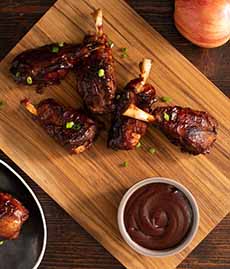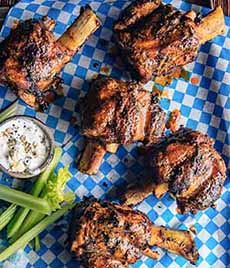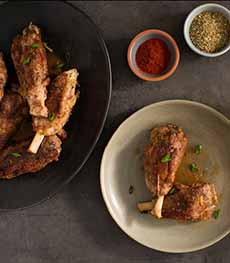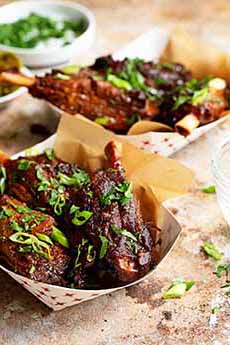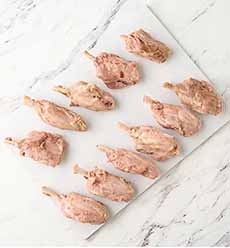Try Pig Wings To Celebrate National Pork Month
|
|
October is National Pork Month (October 12th is National Pork Day). How about something new in pork..say, pig wings? Say what? Pig wings are a whimsical name for a relatively new pork cut made from the fibula of a pig’s lower shank, a single bone surrounded by lean, tender meat (photos #1, #2, and #3—see where the shank is in the diagram below). They’re fun food, great with a beer, great game day food. Pig wings may have been around for the better part of 20 years but didn’t make it to our neck of the woods. We discovered them online, and we’re thankful. Pig wings are similar to ribs but are leaner, with juicy meat, and easier to prepare. They’re even easier when you buy them already cooked, ready to add your own dipping sauces. Their name was bestowed because some people felt that when they are cooked they look like chicken wings. Earlier names included pork hammers and sluggers. We think they look more like pork lollipops. They’ve also been called “pork on a stick” and “pork without the fork.” The meat has the tender mouthfeel of a chicken wing but with the flavor of pork. This specialty cut of pork is made by the butcher from the lower shank of a hock. Here’s a video from the Bearded Butchers. The wings are typically marinated, seasoned, and cooked in a choice of methods (baked, fried, grilled, or smoked). They can be served as tasty finger food, like chicken wings, or can be the protein on a lunch or dinner plate. You may not find pig wings in your grocery store’s meat case, but you can buy the pork shanks and ask the butcher to cut them (or cut them yourself with the instructions in the video). You may find them at Costco and certainly online. A few purveyors: > The history of pork is below. Here’s a basic recipe: Ingredients 1. MARINATE the pig wings. Coat them generously and let the wings marinate for at least 30 minutes to several hours to infuse flavor into the meat. 2. PREHEAT your grill or oven to the desired temperature. 3. COOK until the pig wings are cooked to an internal temperature of 145°F (63°C). Use a meat thermometer to check the temperature. 4. SERVE hot with your favorite dipping sauces. Pig wings weren’t invented by an entrepreneurial ex-pig farmer. Bob File, a former pig farmer and the president of Pioneer Meats, became aware that meat from the lower shank of the pig usually went into the trim bucket and got turned into ground pork. He saw the untapped potential to turn it into a valuable cut. He presented it to commercial channels who are always looking for something new to appeal to consumers. And the rest is history [source]. He and his partner, Bob George, trademarked the name “Pig Wings” in 2003. They then began selling it to chain restaurants, membership warehouses, and online. “Pig wings” emerged as an attractive marketing concept: fun, appealing, and recognizable (via comparison to chicken wings) to consumers. This fun and tasty finger food has the legs (or is that, wings?) to last. |
|
|
THE HISTORY OF PORK The history of pork started, of course, with the domestication of pigs, more than 10,000 years ago. They were first domesticated in the Fertile Crescent, which includes what are now Egypt, southern Iraq, Israel, Lebanon, Jordan, Palestine, Syria, and parts of Turkey and Iran. (Ironically, in some of these countries Islam prohibits the consumption of pork by Muslims.) Domestication occurred during the Neolithic period (also called the New Stone Age), the final stage of cultural evolution and technological development among prehistoric humans. It was characterized by the use of stone tools shaped by polishing or grinding; on settlement in permanent villages by the former nomadic hunter-gatherers, which enabled the domestication of, and dependence on, farmed plants and animals*; and the appearance of such crafts as pottery and weaving [source]. The process of domestication involved the selective breeding of wild boars (Sus scrofa), into what is basically today’s domestic pig (Sus scrofa domesticus). Pigs are relatively easy to raise and they provide valuable meat, leather, and fat. Their domestication played a crucial role in the development of early agriculture and human settlements. Pigs were raised by the major ancient civilizations, including the Chinese, Egyptians, Greeks, Mesopotamians, and Romans. The role of pork in religious and cultural practices varied widely. In some ancient societies, pigs were sacred animals, while in others, they were used as sacrifices. In Abrahamic religions such as Judaism and Islam, pork was and is considered unclean and forbidden for consumption. In contrast, many other cultures, especially in Europe, embraced pork as a staple in their diets. Pork as a major food source in Europe. Pork became a significant part of European cuisines, very popular in Germany, Italy, and Spain. Cured and smoked pork products such as bacon, ham, and sausages were created, and many regions developed their own unique pork dishes. Pork in the Americas. Pigs were first brought to the Americas in the 1500s by early explorers and settlers as a source of food. Free-range livestock management practices and escapes from enclosures led to the first establishment of feral swine populations in North America. The pigs quickly adapted to their new environment and became an important source of meat for the indigenous populations as well as the European colonists [source]. Modern Pork Production. The industrialization of agriculture in the 19th and 20th centuries led to significant changes in pork production. Large-scale pig farms and breeding programs were developed to meet the growing demand for pork. Pork processing and packaging also became more efficient during this time. Pork today. Today, pork is consumed all around the world, and it plays a central role in the diets of many people. The pork industry is a significant part of the global food supply chain. Pork production involves various breeds of pigs, specialized facilities, and modern techniques to ensure food safety and efficiency. The industry also faces ongoing challenges related to animal welfare, environmental sustainability, and public health concerns. The latest data shows that Americans eat an annual 66.18 pounds of pork per capita [source]. Iowa is the top producer by far, with 2.5 times more pigs than its nearest rival, Minnesota, with North Carolina in third place. Illinois, Indiana, Nebraska, Missouri, Ohio, Oklahoma, and South Dakota round out the top 10. Here’s the data. 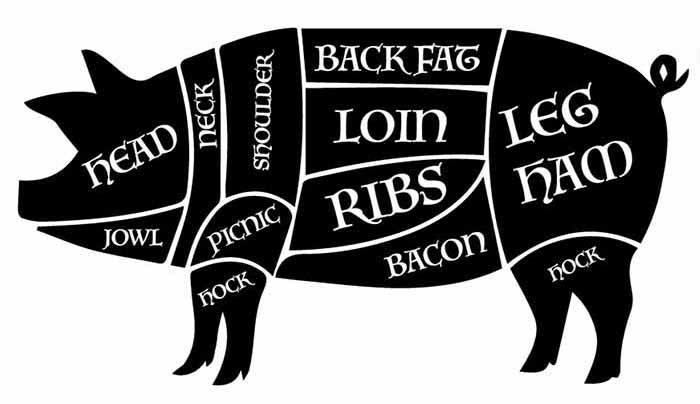 [6] Diagram of the cuts of the pig. Pig wings come from the area right below the hock, which is the shank—but not labeled (illustration courtesy The Webb Ranch | Etsy). _____________________ *Goats were probably the first animals to be domesticated, followed closely by sheep. In Southeast Asia, chickens were also domesticated about 10,000 years ago. The first domesticated plants in the Fertile Crescent were wheat, barley, lentils, and types of peas. CHECK OUT WHAT’S HAPPENING ON OUR HOME PAGE, THENIBBLE.COM.
|
||
